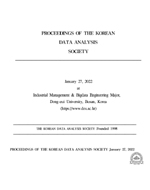Spatial Distribution Pattern of the Patches of Erythronium japonicum at Mt. Geumjeong in Korea
- 한국자료분석학회
- 한국자료분석학회 학술대회자료집
- 2021년 동계학술대회 발표집
-
2022.0139 - 42 (4 pages)
- 6

This study was to describe a statistical analysis for spatial distribution of geographical distances of Erythronium japonicum at Mt. Geumjeong in Korea. The spatial pattern of E. japonicum was analyzed according to the Neatest Neighbor Rule, population aggregation under different sizes of plots by dispersion indices, and spatial autocorrelation. Most natural plots of E. japonicum were uniformly distributed in the forest community. Disturbed plots were aggregately distributed within 5 m x 5 m. Neighboring patches of E. japonicum are predominantly 7.5 m to 10 m apart on average. If the natural populations of E. japonicum were disturbed by human activities, the aggregation was occurred in more short distance than a scale of a 7.5 m~10 m distance. Morisita index (IM) is related to the patchiness index (PAI) showed that the plot 2.5 m x 5 m had an overly steep slope at west and south areas when the area was smaller than 5 m x 5 m. When the patch size was one 2.5 m x 5 m quadrat at west of Mt. Geumjeong, the cluster was determined by both species characteristics and environmental factors. The comparison of Moran’s I values to a logistic regression indicated that a highly significant percentage of individual dispersion in E. japonicum populations at Mt. Geumjeong could be explained by isolation by distance.
Ⅰ. Introduction
Ⅱ. Materials and Methods
Ⅲ. Results
Ⅳ. Discussion
(0)
(0)